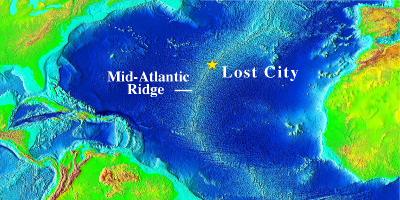April 17, 2003
Science comes to ‘Lost City’
The bizarre hydrothermal vent field discovered a little more than two years ago surprised scientists not only with vents that are the tallest ever seen — the one that’s 18 stories dwarfs most vents at other sites by at least 100 feet — but also because the fluids forming these vents are heated by seawater reacting with million-year-old mantle rocks, not by young volcanism.
 |
| The carbonate structures at the Lost City Field include this chimney, more than 30 feet in height. The white, sinuous spine is freshly deposited carbonate material. The top shows evidence of collapse and re-growth, as indicated by the small newly developed cone on its top. |
The remarkable Lost City hydrothermal vent field, so named partly because it sits on a seafloor mountain named the Atlantis Massif, was discovered in the middle of the Atlantic Ocean about 1,500 miles off the East Coast of the United States during an expedition that wasn’t even looking for hydrothermal vents.
Now the two scientists, who were the first to travel in a submersible to the field after its serendipitous discovery Dec. 4, 2000, are leading a National Science Foundation-funded expedition to map and further investigate the field. A Web site launched recently at http://www.lostcity.washington.edu/ will follow the 32-day expedition that starts April 21.
The field is unlike any seen before, according to chief scientist Deborah Kelley, a UW associate professor of oceanography, and co-chief scientist Jeff Karson, a Duke University professor of earth and ocean sciences. Both have visited fields of black-smoker hydrothermal vents that scientists have been studying since the 1970s.
Lost City is distinctive in part because the mighty 180-foot vent at the site, which scientists named Poseidon, is so much larger than previously studied black-smoker vents that mostly reach 80 feet or less. The tallest black-smoker chimney ever seen was a 135-foot vent off the coast of Washington (which toppled in recent years).
In contrast to black-smoker vents that are a darkly mottled mix of sulfide minerals, Lost City vents are nearly 100 percent carbonate, the same material as limestone in caves, and range in color from a beautiful clean white to cream or gray.
The differences are because hydrothermal venting — a process in which water circulates into the seafloor, gaining heat and chemicals until there is enough heat for the fluids to vent back into the ocean — doesn’t appear connected to volcanic activity and magma chambers. This is unlike most systems at mid-ocean ridge spreading centers. That’s where very young seafloor is created — often dramatically during volcanic eruptions — and vented water can be as hot as 700 F.
Lost City is nine miles from the nearest spreading center and sits on 1.5 million-year-old crust. Heat generated by chemical changes in the rocks appears to drive venting: seawater permeates deeply into the fractured surface of the mantle rocks where it transforms the mineral olivine into a new mineral, serpentine. The heat is not as great as that at volcanically active sites but is enough to power hydrothermal circulation and produce vent fluids of 105 to 170 F.
Lost City vent fluids support a community of microorganisms believed to live off the gases methane and hydrogen, both byproducts of serpentinization. This leads Kelley, Karson and others to speculate that life on this planet may have started in just such an environment, particularly since so much more of Earth’s mantle rock was exposed to seawater early in its history. And the same could be happening on other worlds.
The project includes scientists, engineers and students from the UW, Duke University, Woods Hole Oceanographic Institution, U.S. National Oceanic and Atmospheric Administration, Switzerland’s Institute for Mineralogy and Petrology and Japan’s National Institute of Advanced Industrial Science and Technology.
The team leaves Barbados April 21 on board the Atlantis, operated by Woods Hole. It takes five days to reach the ocean above Lost City where researchers will use the submersible Alvin and an unmanned Autonomous Benthic Explorer.
Among those on the expedition will be lead pilot Pat Hickey, who took Kelley and Karson in the Alvin to see Lost City the day after it was first spotted during routine surveying using an unmanned, remotely operated vehicle. There was time for just a single dive before the expedition ended and bad weather began so scientists can only say the field is 300 feet by perhaps 1,700 feet and has roughly 30 vent structures.
Since the discovery the field has been visited by a U.S. film crew, which conducted no science, and a Russian group, which did limited sampling.
Work this month and next includes studying the waters above the field looking for clues to help find other Lost City fields and visiting a neighboring mountain that looks promising. Researchers also will grow and examine microorganisms recovered from the chimneys.



